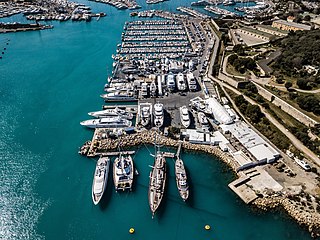
A shipyard is a place where ships are built and repaired. These can be yachts, military vessels, cruise liners or other cargo or passenger ships. Dockyards are sometimes more associated with maintenance and basing activities than shipyards, which are sometimes associated more with initial construction. The terms are routinely used interchangeably, in part because the evolution of dockyards and shipyards has often caused them to change or merge roles.
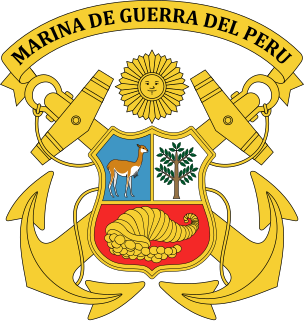
The Peruvian Navy is the branch of the Peruvian Armed Forces tasked with surveillance, patrol and defense on lakes, rivers and the Pacific Ocean up to 200 nautical miles from the Peruvian littoral. Additional missions include assistance in safeguarding internal security, conducting disaster relief operations and participating in international peacekeeping operations.

The Lupo class is a class of frigates built by Cantieri Navali Riuniti (CNR) for the Italian Navy. Designed as multipurpose warships with an emphasis on anti-surface warfare (ASuW), they have enjoyed some success in the export market, being acquired by the navies of Peru and Venezuela. A small run of a slightly updated version is known as the Soldati class.

BAPAlmirante Grau(CLM-81) is a De Zeven Provinciën-class cruiser that served in the Dutch and Peruvian navies. Completed for the Dutch in 1953 as HNLMS De Ruyter (C801), she was acquired by Peru in 1973 and served as fleet flagship. Almirante Grau underwent a major modernization program between 1985 and 1988 during which she was fitted with new weapons and electronics. She was the last gun cruiser in service in any navy before being decommissioned on 26 September 2017. In 2019, it was to be said that she would be preserved as a museum ship. However, it was later announced on 14 February 2022 that the ship would put up for sale with an asking price of 4,180,000 soles.
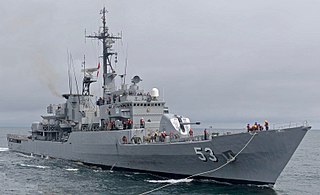
BAP Almirante Grau is the third out of four Carvajal-class frigates ordered by the Peruvian Navy in 1973 and originally named Montero. It was built by SIMA at Callao under license from the Italian shipbuilder Cantieri Navali Riuniti. As such, it was the first modern warship built in Peru. In late 2007 her flight deck was extended to allow ASH-3D Sea King helicopters to land and refuel, even though they can not be housed in the ship's hangar.

BAP Carvajal was the first out of four Carvajal-class frigates ordered by the Peruvian Navy in 1973. It was built by the Italian shipbuilder Cantieri Navali Riuniti at its shipyard in Riva Trigoso, Genoa. Though sea trials were initiated on 9 June 1977 its commissioning was delayed until 23 December 1979 due to delays in equipment deliveries by some subcontractors. In 1998 her flight deck was extended to allow ASH-3D Sea King helicopters to land and refuel, though the hangar is still too small to accommodate them.
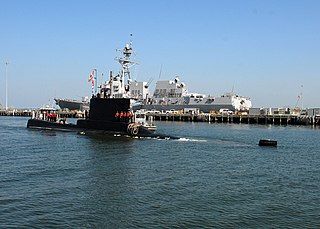
BAP Angamos (SS-31) is one of two Type 209/1200 submarines ordered by the Peruvian Navy on August 12, 1976. She was built by the German shipbuilder Howaldtswerke Deutsche Werft AG at its shipyard in Kiel. She was originally named Casma after a battle which took place between naval forces of Peru and Chile on January 12, 1839. Following sea trials in the North Sea, she arrived to its homeport of Callao in 1981. After a major overhaul by Servicio Industrial de la Marina at Callao SIMA in 1998, she was renamed Angamos after the battle of the same name which took place on October 8, 1879.
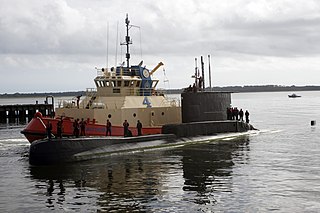
BAP Antofagasta is one of two Type 209/1200 submarines ordered by the Peruvian Navy on 12 August 1976. She was built by the German shipbuilder Howaldtswerke Deutsche Werft AG at its shipyard in Kiel. She is named after the Naval Battle of Antofagasta during the War of the Pacific. Following sea trials in the North Sea, she arrived at its homeport of Callao in 1981. After several years in service she was overhauled by Servicio Industrial de la Marina (SIMA) at Callao in 1996.

The Peruvian Navy Ship BAP Mollendo is a vessel for transportation and logistics. With 18.400 tons displacement and 154 meters in length, was built in the shipyards of the Industrial Service of the Navy of Peru (PERU-SIMA) in El Callao. Was released on July 15, 1970 and commissioned to the Navy May 25, 1972. She was originally named Ilo, and had a sister Rimac. Her present name is after the town of Mollendo in southern Peru.

The Makassar class is a class of South Korean-designed and built Landing Platform Dock, it is named after the city of Makassar in Sulawesi. The ships were designed by Daesun Shipbuilding & Engineering Co. based on their earlier design of Tanjung Dalpele class that was sold to the Indonesian Navy.

The Directorate General of Captaincies and Coast Guard of Peru is the maritime authority and the Peruvian Coast Guard, the same one that carries out the control and surveillance work in maritime, fluvial and lacustrine environments, as well as search and rescue tasks. It is attached to the Navy of Peru, and according to law is empowered to exercise the maritime, fluvial and lacustrine police in order to apply and enforce the national regulations and international instruments of which Peru is a party, for ensure the protection and safety of human life in the aquatic environment, the protection of the aquatic environment and its resources, as well as repress illicit activities within its jurisdiction.

BAP Abtao (SS-42) is an Abtao-class submarine of the Peruvian Navy. The vessel which was originally named BAP Tiburón ("Shark"), was constructed by the American Electric Boat company in the United States and launched in 1953. The Abtao class were the last submarines constructed by the United States for the export market. The submarine entered service in 1954 and by presidential decree, was renamed Abtao for the battle during the Chincha Islands War.

BAP Unión (BEV-161) is a training ship of the Peruvian Navy built between 2012–2015 by Shipyard Marine Industrial Services of Peru, known as SIMA. It is a four-masted, steel-hulled, class "A" barque, composed of 38 steel modules. It has a total length of 115.50 m ; a beam of 13.50 m ; a draft of 6.50 m ; an air draft of 53.50 m ; a displacement of 3,200 tonnes; a speed of 12 knots (22 km/h) and a crew of 250 officers and trainees. The ship's name honors a Peruvian corvette that took part in the first stage of the 1879–1883 War of the Pacific as part of a naval squadron under the command of Miguel Grau, a hero of the Peruvian Navy.

ARA Zurubí (P-55) is a patrol boat of the Argentine Navy, built in the Río Santiago Shipyard in 1938 and based in Ushuaia. The vessel is named after the Surubí, a catfish that inhabits Argentina’s Mesopotamia, and is the first Argentine naval ship with this name.

The BAP Carrasco is an oceanographic research vessel of the Peruvian Navy built in 2016 by Freire Shipyard in Vigo (Spain). Its purpose is to perform oceanographic research cruises both in Peruvian waters and in Antarctica, in order to fulfill Peru's commitment under the Antarctic Treaty. The ship is endowed with technical capabilities for activities of hydrography, oceanography, marine meteorology, and marine geology. It also has polar capability and it is classified with PC7 notation. Since 2017 the ship has become the main platform for Peruvian annual expeditions to Antarctica.
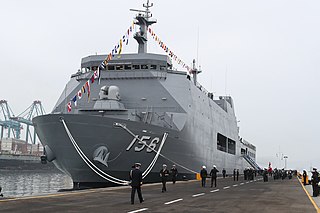
BAP Pisco (AMP-156) is a Makassar-class landing platform dock belonging to the Peruvian Navy that was built between 2013 - 2017 by Shipyard Marine Industrial Services of Peru, known as SIMA.

ROKS Gyeongju (PCC-758) was a Pohang-class corvette of the Republic of Korea Navy. She was decommissioned and transferred to the Peruvian Coast Guard under the name BAP Ferré (PM-211) in 2016 and later reasigned to the Peruvian Navy as BAP Ferré (CM-27).

ROKS Suncheon (PCC-767) was aPohang-class corvette of the Republic of Korea Navy. It was decommissioned and transferred to the Peruvian Navy as BAP Guise (CC-28).

BAP Unión was a corvette of the Peruvian Navy, originally ordered by the government of the Confederate States of America during the American Civil War. Built in France it was bought by the Peruvian Navy and during its service participated in the Chincha Islands War and in the War of the Pacific in which it was scuttled following the Blockade of Callao to prevent it falling into Chilean hands.

The Rupture of the Blockade of Arica was a naval battle of the War of the Pacific during the Blockade of Arica. The rupture was carried out by Manuel Villavicencio who commanded the BAP Unión of the Peruvian Navy. The Unión broke the Chilean blockade of the port twice in less than 8 hours on March 17, 1880.
























